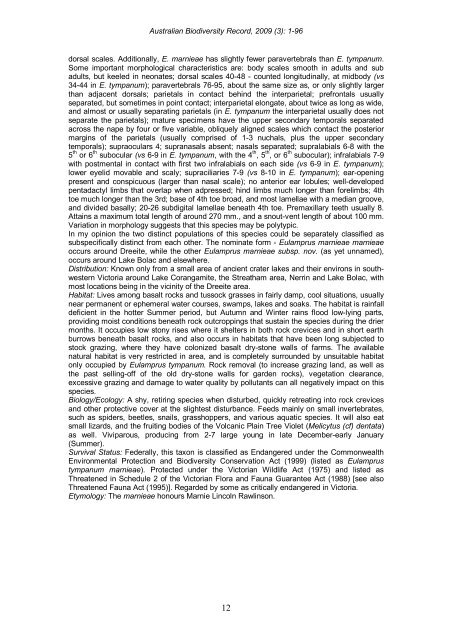AUSTRALIAN BIODIVERSITY RECORD - Calodema
AUSTRALIAN BIODIVERSITY RECORD - Calodema
AUSTRALIAN BIODIVERSITY RECORD - Calodema
Create successful ePaper yourself
Turn your PDF publications into a flip-book with our unique Google optimized e-Paper software.
Australian Biodiversity Record, 2009 (3): 1-96<br />
dorsal scales. Additionally, E. marnieae has slightly fewer paravertebrals than E. tympanum.<br />
Some important morphological characteristics are: body scales smooth in adults and sub<br />
adults, but keeled in neonates; dorsal scales 40-48 - counted longitudinally, at midbody (vs<br />
34-44 in E. tympanum); paravertebrals 76-95, about the same size as, or only slightly larger<br />
than adjacent dorsals; parietals in contact behind the interparietal; prefrontals usually<br />
separated, but sometimes in point contact; interparietal elongate, about twice as long as wide,<br />
and almost or usually separating parietals (in E. tympanum the interparietal usually does not<br />
separate the parietals); mature specimens have the upper secondary temporals separated<br />
across the nape by four or five variable, obliquely aligned scales which contact the posterior<br />
margins of the parietals (usually comprised of 1-3 nuchals, plus the upper secondary<br />
temporals); supraoculars 4; supranasals absent; nasals separated; supralabials 6-8 with the<br />
5 th or 6 th subocular (vs 6-9 in E. tympanum, with the 4 th , 5 th , or 6 th subocular); infralabials 7-9<br />
with postmental in contact with first two infralabials on each side (vs 6-9 in E. tympanum);<br />
lower eyelid movable and scaly; supraciliaries 7-9 (vs 8-10 in E. tympanum); ear-opening<br />
present and conspicuous (larger than nasal scale); no anterior ear lobules; well-developed<br />
pentadactyl limbs that overlap when adpressed; hind limbs much longer than forelimbs; 4th<br />
toe much longer than the 3rd; base of 4th toe broad, and most lamellae with a median groove,<br />
and divided basally; 20-26 subdigital lamellae beneath 4th toe. Premaxillary teeth usually 8.<br />
Attains a maximum total length of around 270 mm., and a snout-vent length of about 100 mm.<br />
Variation in morphology suggests that this species may be polytypic.<br />
In my opinion the two distinct populations of this species could be separately classified as<br />
subspecifically distinct from each other. The nominate form - Eulamprus marnieae marnieae<br />
occurs around Dreeite, while the other Eulamprus marnieae subsp. nov. (as yet unnamed),<br />
occurs around Lake Bolac and elsewhere.<br />
Distribution: Known only from a small area of ancient crater lakes and their environs in southwestern<br />
Victoria around Lake Corangamite, the Streatham area, Nerrin and Lake Bolac, with<br />
most locations being in the vicinity of the Dreeite area.<br />
Habitat: Lives among basalt rocks and tussock grasses in fairly damp, cool situations, usually<br />
near permanent or ephemeral water courses, swamps, lakes and soaks. The habitat is rainfall<br />
deficient in the hotter Summer period, but Autumn and Winter rains flood low-lying parts,<br />
providing moist conditions beneath rock outcroppings that sustain the species during the drier<br />
months. It occupies low stony rises where it shelters in both rock crevices and in short earth<br />
burrows beneath basalt rocks, and also occurs in habitats that have been long subjected to<br />
stock grazing, where they have colonized basalt dry-stone walls of farms. The available<br />
natural habitat is very restricted in area, and is completely surrounded by unsuitable habitat<br />
only occupied by Eulamprus tympanum. Rock removal (to increase grazing land, as well as<br />
the past selling-off of the old dry-stone walls for garden rocks), vegetation clearance,<br />
excessive grazing and damage to water quality by pollutants can all negatively impact on this<br />
species.<br />
Biology/Ecology: A shy, retiring species when disturbed, quickly retreating into rock crevices<br />
and other protective cover at the slightest disturbance. Feeds mainly on small invertebrates,<br />
such as spiders, beetles, snails, grasshoppers, and various aquatic species. It will also eat<br />
small lizards, and the fruiting bodies of the Volcanic Plain Tree Violet (Melicytus (cf) dentata)<br />
as well. Viviparous, producing from 2-7 large young in late December-early January<br />
(Summer).<br />
Survival Status: Federally, this taxon is classified as Endangered under the Commonwealth<br />
Environmental Protection and Biodiversity Conservation Act (1999) (listed as Eulamprus<br />
tympanum marnieae). Protected under the Victorian Wildlife Act (1975) and listed as<br />
Threatened in Schedule 2 of the Victorian Flora and Fauna Guarantee Act (1988) [see also<br />
Threatened Fauna Act (1995)]. Regarded by some as critically endangered in Victoria.<br />
Etymology: The marnieae honours Marnie Lincoln Rawlinson.<br />
12

















